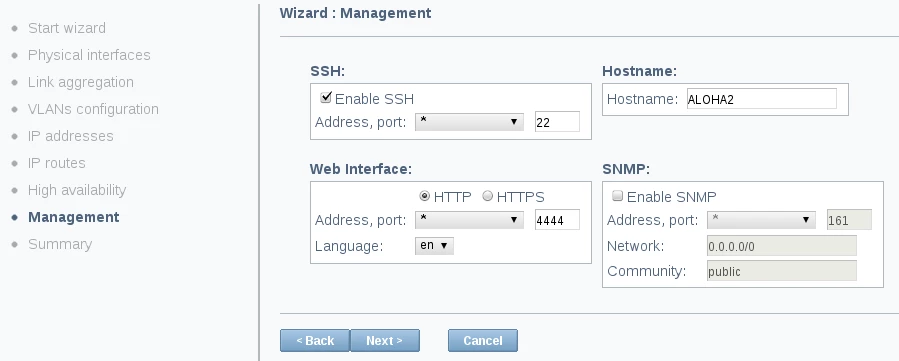HAProxy ALOHA Load Balancer monitoring through SNMP
Synopsis
A load-balancer is one of the key point in an architecture. It can be used to gather information about health of the whole platform.
The ALOHA Load-Balancer can provide many information about server health, farm capacity, sessions and errors, etc…
Configuration
Enabling SNMPd in the ALOHA
During the wizard
When running the wizard, you configure the SNMP daemon at the step #7, also called Management.

In order to enable the SNMP daemon, just:
Check the box Enable SNMP
Choose the Address and port to listen on for SNMP requests
Specify which network is allowed to request ALOHA’s SNMP daemon
Type a Community
On a running ALOHA
If your ALOHA Load-Balancer is already setup and running with production traffic, you don’t want to run the wizard again. To configure SNMP daemon in that case, follow the instruction below:
In the ALOHA GUI, go in the Services tab
Click on the Edit icon from the snmpd line
Comment the line no autostart to allow SNMPd to start with
Configure snmpd as described in the next chapter
Don’t forget to start SNMPd by clicking on the start icon
SNMPd configuration
You can configure the following parameters:
network <network> : authorized network ( default: 0.0.0.0/0 )
community <text> : used community ( default: public )
listen <ip address> : listening ip address ( default: 0.0.0.0 )
port <integer> : listening port ( default: 161 )
ALOHA MIB
Getting the MIBs
ALOHA’s MIB is available on HAProxy Tecnologies website here.
Required third party MIBs are a also available from this URL
MIB installation (Linux)
Download all the required MIBs, unzip them and copy them in a directory on your Linux server.
In this example, we use /usr/src/mibs.
Edit the file /etc/snmp/snmp.conf, and add the path to the mibdirs directive:
mibdirs /usr/src/mibs:/usr/src/mibs/STD-MIBs
printNumericOids no
mibs ALLMIB browsing
OS information
To get information related to Load-Balancing in the ALOHA, just run snmpwalk with the community and the IP address of your ALOHA, and ask for Exceliance’s OID branch: .1.3.6.1.4.1.23263
$ snmpwalk -v2c -c public 192.168.10.3 .1.3.6.1.4.1.23263 | head
EXCELIANCE-MIB::alProductName = STRING: "aloha "
EXCELIANCE-MIB::alProductModel = STRING: "albva"
EXCELIANCE-MIB::alProductVersion = STRING: "5.0"
EXCELIANCE-MIB::alProductSubVersion = STRING: "5.0.3"
EXCELIANCE-MIB::alProductBuildVersion = STRING: "5007"
EXCELIANCE-MIB::alProductBuildDate = STRING: "2012-06-11 18:01:10"
EXCELIANCE-MIB::alProductURL = STRING: "http://www.exceliance.fr/download/aloha/5.0"
EXCELIANCE-MIB::alServiceID.1 = INTEGER: 1
EXCELIANCE-MIB::alServiceID.2 = INTEGER: 2
EXCELIANCE-MIB::alServiceID.3 = INTEGER: 3HAProxy configuration update
In the ALOHA Load-Balancer, each HAProxy’s frontend, backend, listen or server is an object. It owns an ID in HAProxy which is use by SNMPd has the OID. By Default, HAProxy affects IDs in the order the each object is read in the configuration, which means the ID, hence the OID, could change at any moment.
Fortunately, the ALOHA allows you to fix the IDs in HAProxy, so the OID in SNMPd will never change, making third party monitoring tools job easier.
To fix an ID in HAProxy, just add the directive id to each server, frontend, backend and listen.
this ID must be unique for frontend, backend and listen Server IDs must be unique in a backend or in a listen
HAProxy Configuration example:
frontend ft_redis
id 1
bind 192.168.10.2:6379
mode tcp
default_backend bk_redis
backend bk_redis
id 101
mode tcp
option tcplog
server redis1 192.168.10.11:6379 id 1 check maxconn 125
server redis2 192.168.10.12:6379 id 2 check maxconn 125 backup
frontend ft_web
id 2
bind 192.168.10.2:80
mode http
default_backend bk_web
backend bk_web
id 102
mode http
server web1 192.168.10.11:80 id 1 check maxconn 125
server web2 192.168.10.12:80 id 2 check maxconn 125From the example above, the ALOHA will provide the following OIDs:
redis related OIDs
Frontend name: .1.3.6.1.4.1.23263.4.2.1.3.2.1.3.1.1
Frontend status: .1.3.6.1.4.1.23263.4.2.1.3.2.1.13.1.1
Backend name: .1.3.6.1.4.1.23263.4.2.1.3.3.1.3.1.101
Backend status: .1.3.6.1.4.1.23263.4.2.1.3.3.1.20.1.101
Server redis1 name: .1.3.6.1.4.1.23263.4.2.1.3.4.1.4.1.101.1
Server redis2 name: .1.3.6.1.4.1.23263.4.2.1.3.4.1.4.1.101.2
web related OIDs
Frontend name: .1.3.6.1.4.1.23263.4.2.1.3.2.1.3.1.2
Frontend status: .1.3.6.1.4.1.23263.4.2.1.3.2.1.13.1.2
Backend name: .1.3.6.1.4.1.23263.4.2.1.3.3.1.3.1.102
Backend status: .1.3.6.1.4.1.23263.4.2.1.3.3.1.20.1.102
Server web1 name: .1.3.6.1.4.1.23263.4.2.1.3.4.1.4.1.102.1
Server web2 name: .1.3.6.1.4.1.23263.4.2.1.3.4.1.4.1.102.2
Important OIDs to monitor
In the string and numeric OIDs below, replace:
F by the Frontend ID in HAProxy configuration
B by the Backend ID in HAProxy configuration
S by the server ID in HAProxy configuration
Statuses
Description | Type | String | Numeric |
|---|---|---|---|
Frontend status | String | EXCELIANCE-MIB::alFrontendStatus.1.F | .1.3.6.1.4.1.23263.4.2.1.3.2.1.13.1.F |
Backend status | String | EXCELIANCE-MIB::alBackendStatus.1.B | .1.3.6.1.4.1.23263.4.2.1.3.3.1.20.1.B |
Server status | String | EXCELIANCE-MIB::alServerStatus.1.B.S | 1.3.6.1.4.1.23263.4.2.1.3.4.1.19.1.B.S |
Performance
Description | Type | String | Numeric |
|---|---|---|---|
Frontend total sessions | Counter | EXCELIANCE-MIB::alFrontendSessionTotal.1.F | .1.3.6.1.4.1.23263.4.2.1.3.2.1.7.1.F |
Backend total sessions | Counter | EXCELIANCE-MIB::alBackendSessionTotal.1.B | .1.3.6.1.4.1.23263.4.2.1.3.3.1.10.1.B |
Backend current queued sessions | Gauge | EXCELIANCE-MIB::alBackendQueueCur.1.B | 1.3.6.1.4.1.23263.4.2.1.3.3.1.4.1.B |
Server total sessions | Counter | EXCELIANCE-MIB::alServerSessionTotal.1.B.S | .1.3.6.1.4.1.23263.4.2.1.3.4.1.11.1.B.S |
Server current queued sessions | Gauge | EXCELIANCE-MIB::alServerQueueCur.1.B.S | .1.3.6.1.4.1.23263.4.2.1.3.4.1.5.1.B.S |
Server response errors | Counter | EXCELIANCE-MIB::alServerErrorResponse.1.B.S | .1.3.6.1.4.1.23263.4.2.1.3.4.1.16.1.B.S |
ALOHA monitoring through SNMP
This application note is intended to help you configure the Aloha load balancer for SNMP monitoring.
Objective
This application note is intended to help you configure the Aloha load balancer for SNMP monitoring.
Complexity
2
Versions
v4.2 and later